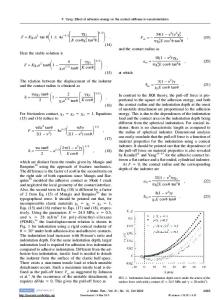Nanoindentation of polydimethylsiloxane elastomers: Effect of crosslinking, work of adhesion, and fluid environment on e
- PDF / 1,010,320 Bytes
- 11 Pages / 612 x 792 pts (letter) Page_size
- 55 Downloads / 378 Views
ikha Gupta Medical Polymers Group, Department of Applied Science and Technology, University of California–Berkeley, Berkeley, California 94720
Mehdi Balooch Department of Preventive and Restorative Dental Sciences, University of California–San Francisco, San Francisco, California 94143
Sally J. Marshall and Grayson W. Marshall Department of Preventive and Restorative Dental Sciences, University of California–San Francisco, San Francisco, California 94143; and University of California–Berkeley/University of California–San Francisco, Bioengineering Joint Graduate Group, San Francisco, California 94143
Lisa Pruitt Department of Mechanical Engineering, University of California–Berkeley, Berkeley, California 94720; and University of California—Berkeley/University of California—San Francisco, Bioengineering Joint Graduate Group, San Francisco, California 94143
Christian M. Puttlitza) Department of Orthopaedic Surgery, University of California–San Francisco, San Francisco, California 94110, and University of California—Berkeley/University of California—San Francisco, Bioengineering Joint Graduate Group, San Francisco, California 94143 (Received 14 December 2004; accepted 14 July 2005)
With the potential to map mechanical properties of heterogeneous materials on a micrometer scale, there is growing interest in nanoindentation as a materials characterization technique. However, nanoindentation has been developed primarily for characterization of hard, elasto-plastic materials, and the technique has not been validated for very soft materials with moduli less than 5 MPa. The current study attempted to use nanoindentation to characterize the elastic moduli of soft, elastomeric polydimethylsiloxane (PDMS) samples (with different degrees of crosslinking) and determine the effects of adhesion on these measurements using adhesion contact mechanics models. Results indicate that nanoindentation was able to differentiate between elastic moduli on the order of hundreds of kilo-Pascals. Moreover, calculations using the classical Hertz contact model for dry and aqueous environment gave higher elastic modulus values when compared to those obtained from unconfined compression testing. These data seem to suggest that consideration of the adhesion energy at the tip-sample interface is a significantly important parameter and needs to be taken into account for consistent elastic modulus determination of soft materials by nanoindentation.
I. INTRODUCTION
For bulk materials, mechanical properties like hardness and elastic modulus are readily described using standard characterization methods such as compression
a)
Address all correspondence to this author. e-mail: [email protected] DOI: 10.1557/JMR.2005.0354 2820
http://journals.cambridge.org
J. Mater. Res., Vol. 20, No. 10, Oct 2005 Downloaded: 10 Jan 2015
and tensile tests. Determination of the mechanical properties of soft and anisotropic materials, such as biological tissues, is complicated by the heterogeneous nature of the tissue, so that the aforementioned bulk testing
Data Loading...











